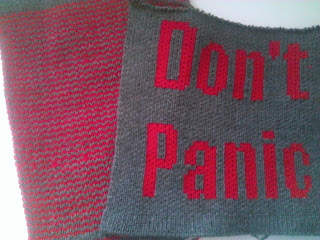There are 3 main techniques for colour knitting on a machine: fairisle, intarsia and double jacquard. Each technique has its own strengths and weaknesses. The same pattern can be used with all three techniques, but with quite differing results.
Fairisle is the simplest technique. It consists of only 2 colours per row. The non-worked colour floats across the back of the worked colour, producing loops called (quite logically) "floats". Therefore this technique works best for patterns where the colours alternate every 5 stitches or less, in order to reduce the length of the floats. The technique is identical to its hand-knitted counterpart. Where long floats are required by the pattern, there are options to try and manage the floats by hooking-up the floats so they are captured by the stitch above, or hooking-up the floats to themselves. Alternatively, the finished item can be lined with stretch netting and attached by stitching the netting to the back of the knit stitches at regular intervals (this tip I picked up from Kim Witcher who gave a fabulous talk at Fleet Machine Knitting Club about the technicolour dreamcoats she makes for the Joseph musicals).
On machines that have a built-in carriage setting for fairisle, or a specialised fairisle carriage, the knitting is created very quickly. 2 cones are set up, with the main colour and the contrast/pattern colour both being loaded through the carriage. The main colour will be worked on the needles in the working position, and the contrast colour worked on the needles in the upper working position. No hand-manipulation of the stitches is required. In combination with an appropriate colour-changer, both the main and contrast colours can be alternated on every-other row (when the carriage is on the colour side of the machine).
Intarsia was a very popular technique during the 80s and 90s when picture knitting was very much in fashion. As with fairisle, the machine knitting technique is very similar to its hand-knitting counterpart. Multiple colours can be used in each row. A small amount of each colour of yarn is wrapped into a small skein (butterflies is a term I have often seen used). Each coloured yarn is laid over the needles as per the pattern dictates. The carriage is moved across. Then, the yarns are laid over the needles again, but with care taken to overlap the end of each yarn over the start of the next yarn. This stops holes appearing between colours. This technique is also very close to its hand-knit equivalent.
Intarsia works well on large bold blocks of colour, and designs that require more than 2 colours per row. It is manually intensive, compared to fairisle, but with practice, it can become quite fluid.
Intarsia works well on large bold blocks of colour, and designs that require more than 2 colours per row. It is manually intensive, compared to fairisle, but with practice, it can become quite fluid.
Double Jacquard is the most complex. The technique requires a double-bed machine (flat-bed knitting machine plus a ribber-bed that sits perpendicular to the flat bed). The two sets of needles allows two layers of knitting to be done at the same time. The yarn is interwoven between the front and back of the fabric. This results in no floats! Therefore, very complex and intricate patterns can be created without the need to worry about how many stitches of each colour are used. The downside is that the technique is complex to get the hang of, does have a habit of sometimes ending up as a big yarn birds nest, and requires a machine in top-notch condition to reduce the risk of dropped stitches.
Jacquard works well for cut and sew designs because of the difficulty to shape the knitting whilst it is on the double-bed. I think of it as producing a fabric rather than knitting a garment.
Jacquard works well for cut and sew designs because of the difficulty to shape the knitting whilst it is on the double-bed. I think of it as producing a fabric rather than knitting a garment.



